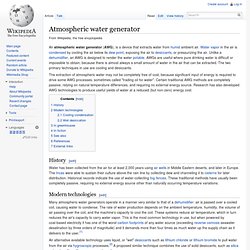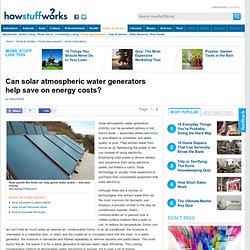

Air to Water - Water from Air - Home. The Low Down on Home Water Makers and 7 to Choose From. Photo via jenny downing via Flickr CC As the water crisis becomes more real, with droughts, pollution, depleted snow packs and other issues shortening our fresh water supplies, there is one technology that you'll want to boost your water IQ with - atmospheric water generation.

While it sounds like something for a distant, drastically different future, there are actually residential water generators on the market today. Find out how the technology works, and what options are out on the market if you want one for your home. Atmospheric Water Generators, aka Home Water Makers, Explained What's an atmospheric water generator? How does a water maker work? Chart from Air2Water showing how the Dolphin 2 works, which is much how most AWGs work.
But the amount of water a machine can collect and how energy efficient and cost effective its use is, all depends upon a balance of ideal conditions. Atmospheric water generator. An atmospheric water generator (AWG), is a device that extracts water from humid ambient air.

Water vapor in the air is condensed by cooling the air below its dew point, exposing the air to desiccants, or pressurizing the air. Unlike a dehumidifier, an AWG is designed to render the water potable. AWGs are useful where pure drinking water is difficult or impossible to obtain, because there is almost always a small amount of water in the air that can be extracted. The two primary techniques in use are cooling and desiccants. The extraction of atmospheric water may not be completely free of cost, because significant input of energy is required to drive some AWG processes, sometimes called "trading oil for water". History[edit] Modern technologies[edit] Many atmospheric water generators operate in a manner very similar to that of a dehumidifier: air is passed over a cooled coil, causing water to condense. Cooling condensation[edit] Example of cooling-condensation process. Wet desiccation[edit] Can solar atmospheric water generators help save on energy costs?"
Solar atmospheric water generators (AWGs) can be excellent options in hot, humid areas -- especially where electricity is unavailable or unreliable, and water quality is poor.

They extract water from humid air by harnessing the power of the sun instead of using electricity. Employing solar power is almost always less expensive than using electrical power, but there's a catch. Solar technology is usually more expensive to purchase than comparable equipment that uses electricity. Although there are a number of technologies that extract water from air, the most common for domestic use employs a process similar to the way air conditioners operate: Warm, moisture-laden air is passed over a chilled surface medium like a plate or coil, to reduce its temperature.
Since cool air can't hold as much water as warmer air, condensation forms. Water generators also need a relative humidity of around 40 percent or more, and a temperature of at least a few degrees above freezing to work efficiently.